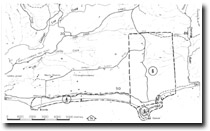8622-5 Cape Conran
|
This information has been developed from the publications:
|
Location: | 520134. 17 kilometres east of Marlo. | |
Abstract: | Headland displaying contact between granodiorite and Ordovician sedimentary rocks. | |
Access: | Marlo – Cape Conran Road. | |
Ownership: | Crown Land. | |
Geology/Geomorphology: | The main headland at Cape Conran is a narrow promontory of strongly sheared granodiorite. The orientation of the shoreline follows the direction of the shear planes which dip westerly at 40º and determine the shape of the main erosion gutters. Ordovician sandstones and slates outcrop along the coastline to the east of the granodiorite, the contact between these rocks being well displayed in the shore platform and low coastal cliffs. Graptolites have been reported from the Ordovician sediments. A narrow zone of contact metamorphism is marked by the alteration of the sedimentary rocks. Further east, the sediment show minor faulting and folding. | |
Significance: | State. The contact between the granitic and sedimentary rocks is one of the best, and most accessible, igneous contacts displayed on the Gippsland Coast. | |
Management: | Any proposed port developments need to be designed to preserve the display of rock structures in the cliffs and shore platforms for at least 500 metres on each side of the contact zone | |



